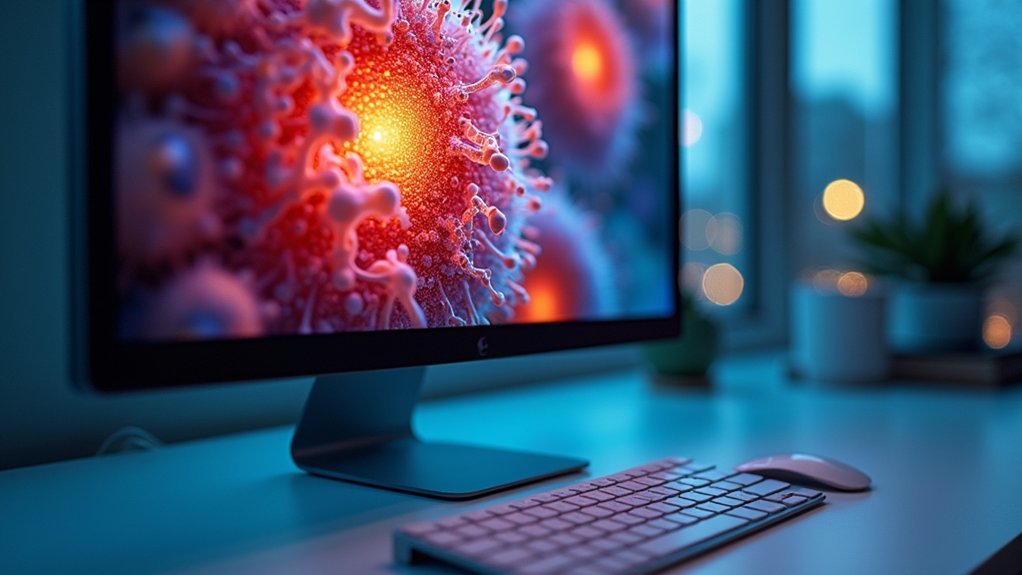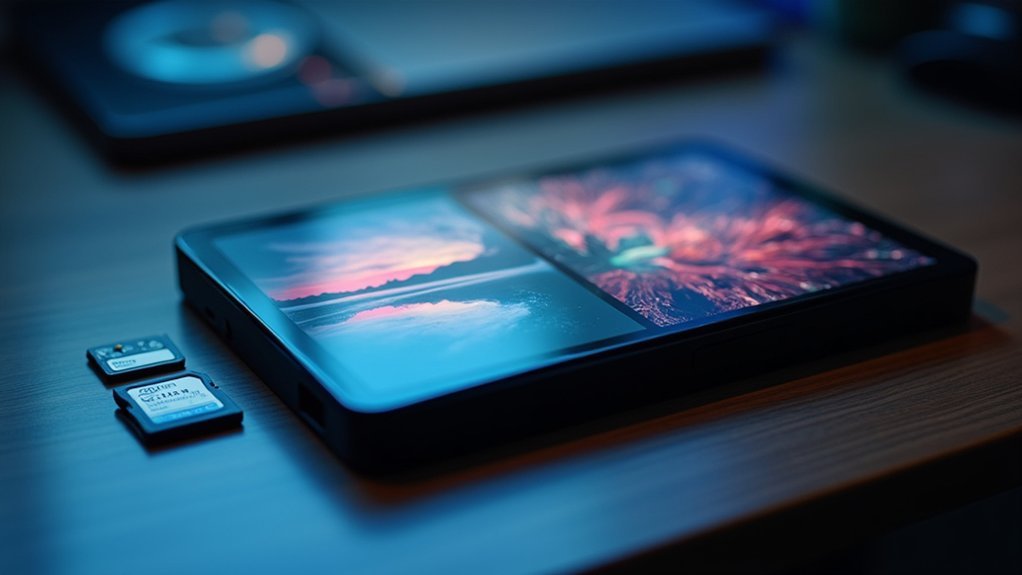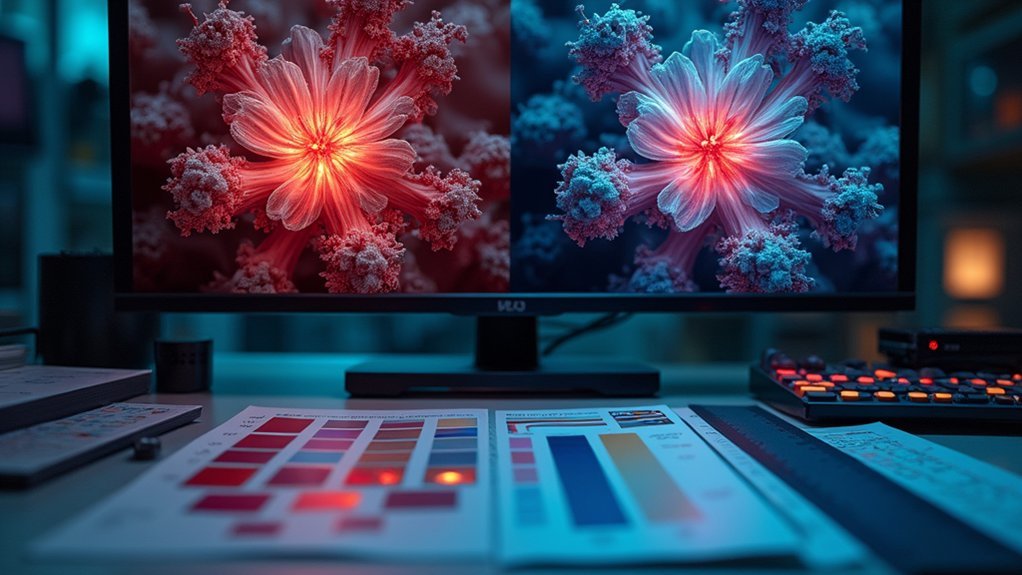When capturing scientific images, choose RAW over JPEG for superior data integrity. RAW’s 14-bit depth offers 16,384 tonal values versus JPEG’s 8-bit with only 256, enabling better detail recovery in highlights and shadows. While RAW files require more storage, they allow non-destructive editing and preserve measurement accuracy. Consider shooting RAW for critical specimens and JPEG for routine documentation. The following tips will enhance your scientific imaging workflow and guarantee reliable research outcomes.
5 Tips: RAW Vs JPEG for Scientific Imaging

When capturing images for scientific research, choosing the right file format isn’t just a technical preference—it’s essential to your data integrity. RAW files preserve all sensor data, providing superior dynamic range that’s vital when you need to recover details in highlights and shadows. This preservation becomes especially valuable in scientific imaging applications where precise measurements matter.
Unlike JPEG images that introduce compression artifacts and limit editing flexibility, RAW formats allow for non-destructive editing of your data. You’ll maintain full image quality while making adjustments important for analysis.
For applications like photogrammetry, consider creating controlled TIFFs or JPEGs from minimally processed RAW files to avoid unwanted alterations such as sharpening or tone curve adjustments. This workflow guarantees your scientific imaging maintains calibration accuracy while giving you maximum flexibility for post-processing techniques.
Understanding Bit Depth: Why Raw’s 14-Bit Vs Jpeg’s 8-Bit Matters in Microscopy
Although many researchers focus primarily on resolution, bit depth represents one of the most critical yet overlooked aspects of scientific imaging in microscopy. When you capture in RAW at 14-bit depth, you’re recording over 16,000 tonal values per channel compared to JPEG’s mere 256 values at 8-bit.
| Feature | RAW (14-bit) | JPEG (8-bit) |
|---|---|---|
| Tonal Values | 16,384 per channel | 256 per channel |
| Detail Recovery | Excellent in highlights/shadows | Limited, often lost |
| Post-processing Flexibility | High dynamic range adjustments | Minimal before degradation |
This difference isn’t just theoretical—it directly impacts your ability to analyze subtle structures. You’ll find superior exposure correction and color balance adjustment options with RAW files, ensuring accurate representation of your microscopy samples without the banding artifacts common in heavily processed JPEGs.
Storage Considerations: Balancing Image Quality and Data Management

The three-fold storage challenge facing scientific microscopy researchers stems directly from RAW’s superior bit depth.
You’ll need to manage RAW files that consume 2-6 times more storage space than JPEG files, while maintaining image quality for scientific imaging.
Consider your project’s storage requirements carefully—high-megapixel images can quickly fill drives, potentially requiring up to 9 Tb of storage with proper backup solutions.
External drives become essential when managing large datasets that demand redundancy.
While RAW files offer superior editing flexibility for detailed analysis, they create significant data management hurdles.
A balanced shooting method might be your solution—capturing critical specimens in RAW while using JPEG for routine documentation.
This approach preserves your ability to conduct detailed analysis while minimizing storage demands.
Post-Processing Flexibility: Preserving Microscopic Details in RAW Files
Beyond storage concerns, RAW file formats offer unparalleled advantages in preserving microscopic details during post-processing—a key consideration for scientific imaging.
When you capture in RAW, you’re retaining all image data recorded by the sensor, with no compression compromising your results.
You’ll appreciate the expanded dynamic range, allowing you to recover vital details in shadows and highlights that might otherwise be lost in JPEGs.
The 14-bit depth provides a notably richer color range than JPEG’s 8-bit limitation—essential when documenting subtle variations in specimens.
Perhaps most valuable is the ability to make non-destructive adjustments to white balance and exposure after capture.
This means you can repeatedly refine your images while maintaining the original data integrity, giving you maximum flexibility for accurate scientific analysis without sacrificing quality.
Calibration and Measurement Accuracy: Format Impact on Quantitative Analysis

When conducting quantitative analysis in scientific imaging, your choice between RAW and JPEG formats directly impacts measurement precision and experimental validity. RAW files preserve the full dynamic range and detail from your sensor, essential for accurate calibration measurements that would otherwise be compromised by JPEG compression.
Unlike professional photographers who might prioritize aesthetics, your scientific work demands data integrity above all. RAW files allow precise exposure correction and white balance adjustments without degrading original information. This becomes critical when aligning calibration images, where even minor compression artifacts can introduce measurement errors.
For dependable quantitative analysis, avoid applying sharpening or tone adjustments to your RAW files. These processing steps, while visually appealing, can distort the actual measurements your research depends on, undermining scientific rigor.
Frequently Asked Questions
Do Professional Photographers Use RAW or JPEG?
Professional photographers primarily use RAW files for their greater editing flexibility, wider dynamic range, and post-processing capabilities. You’ll find they often shoot RAW+JPEG to have both high-quality editing files and ready-to-share images.
What Is a Reason That a RAW File Would Be Better Than a JPEG?
RAW files give you greater post-processing flexibility. You’ll retain all the original sensor data, allowing you to recover shadows, adjust white balance, and make significant edits without degrading image quality like JPEGs would.
What Are the Disadvantages of RAW Images?
You’ll face larger file sizes with RAW images, requiring more storage space. They’ll demand specialized software, longer processing times, and can overwhelm your storage capacity quickly. Without proper knowledge, you might over-edit scientific images.
Why Don’t Photographers Do RAW Photos?
You’ll find that many photographers avoid RAW photos due to larger file sizes, storage demands, and the time-consuming post-processing workflow. JPEGs offer convenience and immediacy when editing isn’t your priority.
In Summary
You’ll find that RAW offers uncompromised data integrity for scientific imaging, though it demands more storage space. When accuracy counts in your research, RAW’s 14-bit depth preserves details that JPEG might discard. Consider your workflow needs carefully – if you’re conducting quantitative analysis or need post-processing flexibility, RAW is worth the extra effort. For routine documentation where absolute precision isn’t critical, JPEG remains a practical option.





Leave a Reply